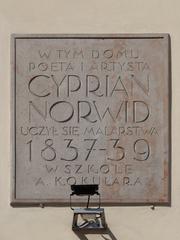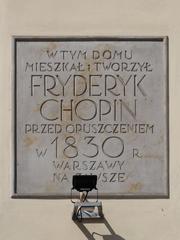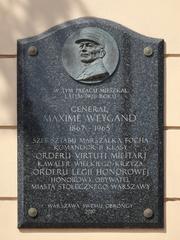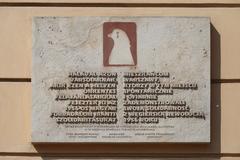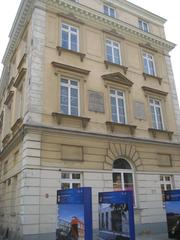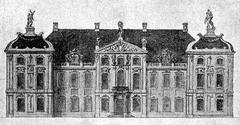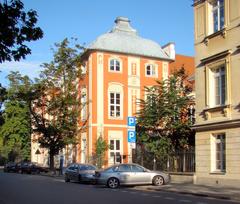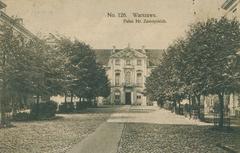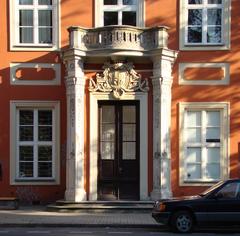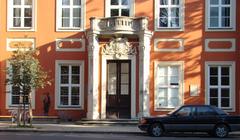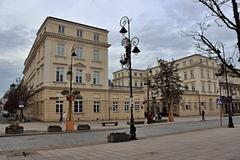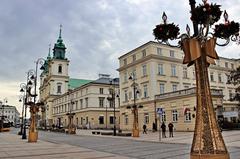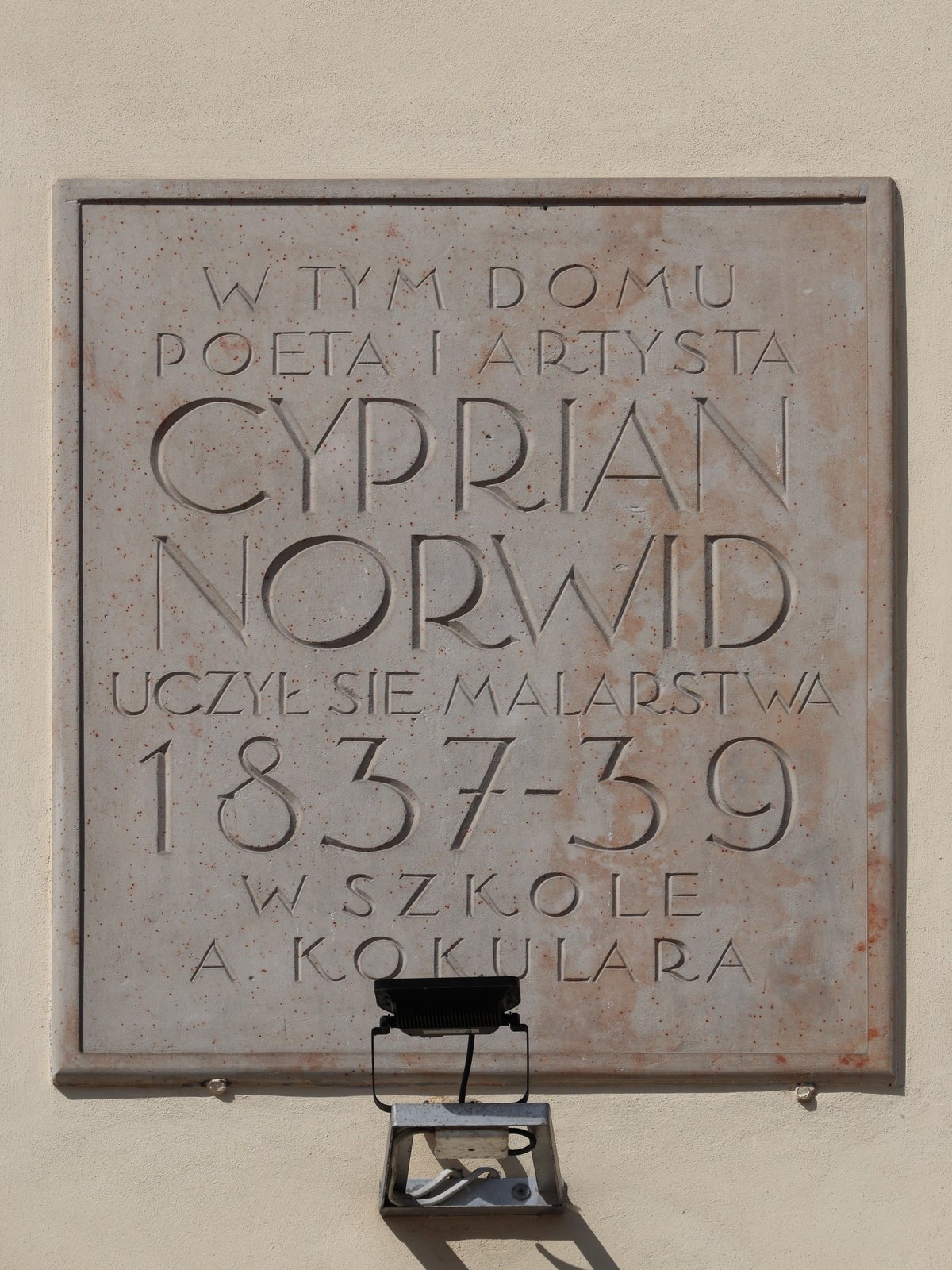
Czapski Palace: Visiting Hours, Tickets, and Comprehensive Guide to Warsaw’s Historical Treasure
Date: 14/06/2025
Introduction: Czapski Palace—A Pillar of Polish Heritage
Located on the iconic Krakowskie Przedmieście, Czapski Palace is a monument to Poland’s rich artistic, architectural, and intellectual legacy. Commissioned by the Czapski family in the late 17th century and later refined by the Krasiński lineage, the palace’s evolving Baroque and Rococo styles reflect centuries of Polish history. Its halls have housed luminaries like poet Zygmunt Krasiński and composer Frédéric Chopin, the latter commemorated today in the meticulously recreated Chopin Family Parlor.
Now home to the Warsaw Academy of Fine Arts (Akademia Sztuk Pięknych w Warszawie), Czapski Palace continues to foster artistic innovation, presenting visitors with a harmonious blend of historical architecture and vibrant contemporary culture. This guide offers detailed, up-to-date information on visiting hours, tickets, accessibility, and nearby attractions, ensuring you make the most of your visit to this essential Warsaw landmark.
For the latest updates, consult the official Academy of Fine Arts website or Culture.pl.
Table of Contents
- Czapski Palace at a Glance
- Historical Overview and Architectural Evolution
- Cultural Significance and Notable Residents
- Wartime Destruction and Restoration
- The Modern Palace: Academy of Fine Arts
- Visitor Information
- FAQs
- Local Tips
- Sources
Czapski Palace at a Glance
Czapski Palace (Pałac Czapskich), sometimes called Krasiński Palace, is one of Warsaw’s most distinguished historic sites. Its Baroque and Rococo architectural features, storied past, and central location make it a must-see for visitors interested in Polish culture and history.
Historical Overview and Architectural Evolution
Originally constructed in the 17th century by the Czapski family, the palace was designed in the Baroque style by Tylman van Gameren. The Krasiński family’s 18th and 19th-century renovations introduced harmonious neoclassical and rococo elements, creating its present-day appearance. Significant reconstructions by architects like Agostino Locci and Jan Chrystian Kamsetzer added further depth to its aesthetic (Wikipedia; Culture.pl).
Key Features:
- Baroque façade: Symmetrical, ornate, with decorative stucco and pilasters.
- Alkierze: Corner projections reminiscent of medieval towers.
- Grand entrance: Flanked by allegorical figures representing the Four Seasons.
- Classicist annexes: Added in the late 18th and 19th centuries.
Cultural Significance and Notable Residents
The palace has played a pivotal role in Polish intellectual and artistic life. In the 19th century, it was home to Zygmunt Krasiński, one of Poland’s famed “Three Bards,” and a meeting place for artists, writers, and thinkers during periods of foreign occupation. Frédéric Chopin lived in the south annex between 1827 and 1830; his reconstructed family parlor remains a highlight for visitors (Wikipedia).
The palace also hosted artist Zygmunt Vogel, known for his watercolors of Warsaw, and inspired poets like Cyprian Norwid.
Wartime Destruction and Restoration
The palace suffered extensive damage during World War II, particularly in the 1944 Warsaw Uprising. Restoration efforts between 1948 and 1959, guided by archival materials, painstakingly returned the palace to its 18th-century grandeur. This endeavor became a symbol of Warsaw’s resilience and commitment to cultural preservation (Lonely Planet).
The Modern Palace: Academy of Fine Arts
Today, Czapski Palace houses the Warsaw Academy of Fine Arts, a premier institution for the visual arts. The palace is a hub for exhibitions, lectures, and educational programs. The Museum of the Academy of Fine Arts, located in the attic, contains approximately 30,000 works, including painting, sculpture, graphics, and design (Wikipedia).
Recent Notable Exhibitions:
- “And Now Photography” (2024–2025): A sweeping retrospective of Polish photography.
- Łukasz Korolkiewicz: “Prof. K.’s Experiment” (2024): A solo exhibition by the noted painter and educator.
- “Włodzimierz Szymański 1960–2023”: A tribute to the influential professor’s legacy.
The palace’s courtyards also feature public art, such as the replica of Andrea del Verrocchio’s equestrian statue of Bartolomeo Colleoni (Wikipedia).
Visitor Information
Hours and Admission
Standard Opening Hours:
- Monday–Friday: 10:00 AM – 6:00 PM
- Saturday: 10:00 AM – 4:00 PM
- Sunday: Closed
Note: Hours may vary during holidays or for special events. Confirm before visiting on the official website.
Admission:
- General: 15 PLN
- Reduced (students, seniors): 10 PLN
- Children under 7: Free
- Guided tours available by appointment (fees apply).
Accessibility
Czapski Palace features ramps and elevators, making it accessible for wheelchair users and visitors with mobility needs. Accessible restrooms are provided. For specific accommodations, contact the Academy in advance.
Guided Tours and Events
- Guided Tours: Available upon request; advance booking is recommended.
- Workshops and Lectures: Regularly hosted by the Academy of Fine Arts.
- Exhibitions: Check the museum calendar for current and upcoming shows.
Getting There
- Address: 5 Krakowskie Przedmieście, Warsaw.
- Public Transport: Tram and bus stops at Nowy Świat-Uniwersytet and Krakowskie Przedmieście.
- Metro: Nowy Świat-Uniwersytet station (10-minute walk).
- Parking: Limited street parking and public garages nearby.
Nearby Attractions
- Presidential Palace
- Holy Cross Church
- Nicolaus Copernicus Monument
- University of Warsaw
- Royal Castle
- Krakowskie Przedmieście and Nowy Świat Street
For expanded sightseeing, browse Warsaw Tourism Board.
Frequently Asked Questions (FAQ)
Q: What are Czapski Palace’s visiting hours?
A: Monday to Friday, 10:00 AM–6:00 PM; Saturday, 10:00 AM–4:00 PM; closed Sunday.
Q: How much are tickets?
A: General admission is 15 PLN; reduced 10 PLN; children under 7 free.
Q: Is the palace accessible for people with disabilities?
A: Yes, the palace is equipped with ramps, elevators, and accessible restrooms.
Q: Can I book a guided tour?
A: Yes, guided tours are available by appointment.
Q: What is the best way to get there?
A: The palace is easily accessible via tram, bus, or metro (Nowy Świat-Uniwersytet station).
Local Tips for a Memorable Visit
- Best Time: Visit on weekday afternoons for fewer crowds.
- Photography: Personal photography is allowed; check for restrictions during exhibitions.
- Events: Check the Academy’s calendar for special exhibitions and workshops.
- Dining: Enjoy a meal at one of the many cafes along Krakowskie Przedmieście or Nowy Świat.
- Travel Apps: For real-time updates and virtual tours, use guide apps like Evendo (Evendo).
Summary
Czapski Palace is a living testament to Warsaw’s enduring artistic and intellectual traditions. Its architecture, vibrant exhibitions, and central location make it an essential destination for anyone interested in Polish history and culture. Whether you’re exploring the Chopin Family Parlor, attending a contemporary art show, or simply admiring the Baroque façade, Czapski Palace offers a unique and enriching experience.
For up-to-date visitor information, special events, and digital resources, refer to the Warsaw Academy of Fine Arts website and the Warsaw Tourism Board.
Visual and Interactive Resources
- Czapski Palace façade image (Alt: Czapski Palace Baroque and Neoclassical façade in Warsaw)
- Virtual tour of Czapski Palace
Sources
- Culture.pl – 8 Beautiful Palaces in Warsaw
- Warsaw Academy of Fine Arts Official Site
- Warsaw Tourism Board
- Evendo – Czapski Palace Warsaw
- Lonely Planet: Czapski Palace
- Wikipedia: Czapski Palace
- Trek Zone: Czapski Palace Warsaw
